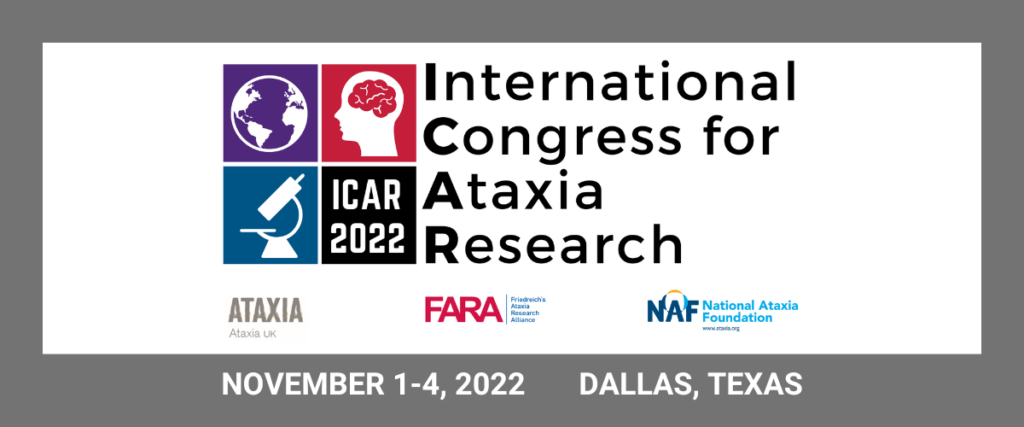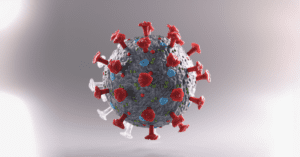
Written by Dr. Hannah Shorrock, with notes from Dr. Amy Smith-Dijak and Celeste Suart
Edited by Celeste Suart
Understanding non-motor functions and factors that govern vulnerability in the cerebellum will help to inform preclinical therapy development, from CRISPR to small molecules, and provides important considerations for imaging studies.
Together, these research areas pave the way, not only for novel therapeutics but for a better understanding of the range of symptoms patients may experience as well as novel imaging diagnostics and better biomarkers for tracking disease onset and progression.
“It’s not in your mind, it’s in your brain” – Dr Louisa Selvadurai, ICAR Speaker (a quote from Dr Jeremy Schmahmann, Massachusetts General Hospital)
The plenary session on Wednesday afternoon was all about understanding the non-motor functions of the cerebellum and the neural circuits that are responsible for these functions. Traditionally the cerebellum has been thought of as only controlling complex motor functions like balance and coordination. Hence, when there is degeneration of the cerebellum this leads to impaired balance and coordination. End of story…. But it is not the end of the story of cerebellar function.
When imaging the cerebellum, a large proportion ‘lights up’ when participants undertake non-motor activities, indicating that these activities require cerebellar function. This translates to there being many connections from the cerebellum to regions of the rest of the brain that have nothing to do with balance and coordination. Not surprisingly, damage to the cerebellum can have behavioral and cognitive outcomes as well as effects on movement. The first talk of the plenary session by Dr Peter Tsai left the audience in no doubt about two things: First, the cerebellum is connected to regions of the brain relevant to non-motor function. Second, the cerebellum is critical for mediating those non-motor behaviors. What followed in the rest of the session was a series of talks outlining non-motor symptoms of ataxia caused by degeneration of the cerebellum.
In a similar way to how the SARA scale measures ataxia, the cerebellar cognitive affective syndrome scale (CCAS-S) can be used to measure dysmetria, or a lack of coordination, of thought. By measuring CCAS-S across Spinocerebellar Ataxias (SCAs), it was identified that symptomatic patients perform worse on the CCAS-S than premanifest or control individuals. Higher levels of education resulted in better performance on the CCAS-S with increasing disease duration and increasing ataxia severity correlating with worse performance on CCAS-S. Based on the CCAS-S, there was also some evidence that suggested that cognitive and neuropsychiatric deterioration may occur before ataxia onset in some individuals. Also looking before ataxia onset, another group analyzed MRI data from pre-ataxic SCA3 individuals and identified that there is a non-motor nature to the functional differences present before ataxia onset.
Finally, we also heard from a study that originated due to the transition to telemedicine during the COVID-19 pandemic. The team that conducted this study realized that patients display more impulsive and compulsive behaviors in their home settings than in the clinic. By studying three different types of impulsivity, the group identified that non-planning impulsivity was increased in patients with cerebellar ataxia but that there was no correlation with CCAS-S. This indicates that impulsivity may be another cognitive effect, alongside CCAS, of cerebellar degeneration experienced by ataxia patients. Together this work has important implications for patient care and the implementation of interventions that can help manage the cognitive symptoms of cerebellar degeneration.
The multiple components of cerebellar degeneration
The first of three breakout sessions carried on the theme of cerebellum function and dysfunction in a workshop on this topic. Presentations in this workshop covered the regional and selective vulnerability in SCAs. One group identified that the posterior vermis region of the cerebellum, a region of increased vulnerability to cerebellar degeneration, shows alterations in gene expression. This indicates that these molecular alterations may be contributing to regional vulnerability. Interestingly, another group showed that there is also differential vulnerability of Purkinje neurons during normal aging. In a new mouse model of Friedreich’s Ataxia, it was demonstrated that the cerebellar astrocytes can also contribute to the neurodegenerative process. The group identified that the mitochondrial and metabolic functions of the astrocytes were disrupted resulting in a shift in their behavior.
Mirroring talks from the plenary session, the final talk in the workshop discussed a non-motor symptom of cerebellar ataxia. By performing learning tests, the group found that patients with cerebellar dysfunction have deficits in reward-based learning and that they use other memory systems to compensate. Together, these studies improve our understanding of why, how, and to what effect the cerebellum degenerates in ataxia and enable us to identify and move toward appropriate interventions, biomarkers, and therapies.
Imaging techniques as biomarkers and diagnostic tools
While rating scales are used to measure the effects of cerebellar degeneration, imaging techniques can be used to see where, and understand how, that degeneration is happening. To use imaging as a biomarker or diagnostic we must identify what to measure and understand how these measurements change over time. This was reported on in five studies of Friedreich’s ataxia focused on imaging the spinal cord, dorsal root ganglia, heart, and connections between the cerebellum and other brain regions. For each of these regions, differences were found between healthy controls and Friedreich’s Ataxia patients including increased left ventricular volume in the heart and reduced cross-sectional area of the spinal cord. Rather than investigating changes in the size of specific regions, one talk reported on imaging neuroinflammation in Friedreich’s Ataxia. The group found increased neuroimmune activity in the cerebellum and brainstem which may be related to an earlier age of onset. Finally, there were two talks on brain imaging in SCA3 that identified differences in white matter regions and microstructural features between premanifest individuals and healthy controls. Both studies require further follow-ups with larger group sizes to establish the potential use of these biomarkers for monitoring the pre-ataxic stage of SCA3.
While most imaging studies focused on potential biomarkers, one demonstrated that imaging could be diagnostic for multiple system atrophy of the cerebellar type (MSA-C). It is challenging to diagnose MSA-C and diagnosis commonly only occurs after death. In this study, the research group analyzed MRIs from multiple ataxias, MSA-C, and healthy controls. They identified large differences between MSA-C and ataxia individuals in specific measurements in the brain. As these measurements were unique to MSA-C and evident at all stages of the disease, they could be used to facilitate diagnosis during a patient’s life. This would be incredibly valuable to patients and clinicians who would gain an understanding of how best to manage this devastating disease.
From CRISPR to small molecules: advances in therapeutic approaches for ataxia
Many different approaches can be used to treat model systems of ataxia and recent advances in these approaches were discussed in the final breakout session on Wednesday afternoon. Some of these new approaches were based on advances in therapeutic technologies, others were based on an improved understanding of disease mechanisms, and still more were based on taking a different approach to therapeutics in ataxias.
By understanding the genetic cause of Christianson syndrome, an epileptic and ataxic encephalopathy, researchers have been able to identify that gene therapy to restore levels of the affected protein improves cerebellar health and prevents motor ataxia in a rat model of this disease. Likewise, understanding that mutant ATXN3 protein is a key pathogenic entity in SCA3 has enabled researchers to use RNA silencing approaches to reduce the levels of the ATXN3 RNA and protein. Typically, RNA silencing therapies are delivered by injection into the mouse brain which has limited applicability for patients. Recent advances have led to a less invasive delivery route and RNA silencing therapies in SCA3 mice have now been tested via delivery using extracellular vesicles and an intranasal aerosol-based system. Similarly, following advances in gene editing, researchers demonstrated that CRISPR-mediated reductions in the length of CGG repeats in FXTAS mice can improve motor performance.
The final three talks of the session focused on using small molecule approaches. One group used an inhibitor of Hsp90 to activate the heat-shock response which improved cellular defects in models of ARSACS. Another research team used an FDA-approved small molecule to reduce the levels of RAN proteins in SCA8 mice which improved behavior phenotypes. By developing a small molecule screening system another group identified compounds capable of reducing levels of CAG expansion containing RNAs in patient fibroblast lines from SCA1 and SCA3. Targeting pathways that regulate levels of disease-causing RNAs or proteins has the potential to identify therapies that could be used across multiple ataxias. If effective in long-term studies in mice, small molecules that are already FDA-approved could be rapidly moved into clinical trials.
The art of communication
At the end of Wednesday afternoon, there was one final session on communication. Specifically, on how to communicate scientific findings to a general audience. This is something that scientists struggle with, but it is of the utmost importance. Scientists have a responsibility to communicate their research with the public to inform and highlight the benefits and risks of new technologies or information and their impact on society. This should be done clearly, directly, and succinctly. In this session, scientists learned best practices on how to communicate to a general audience and how to avoid our usual world of passive descriptions, specialized language, and statistical terminology. To cement the key teachings, the workshop leader took advantage of our willingness to flex our pop-quiz muscles, and some cool science-themed prizes were enthusiastically competed for. Despite the light-hearted end to this session, it will provide one of the more immediately tangible benefits for patients and families: improved communication on what scientists are learning from their research and how that might translate into treatments for ataxia.
About the Author and Editor
Hannah Shorrock is a postdoctoral researcher at the RNA Institute, University at Albany, studying small molecule therapeutic approaches for spinocerebellar ataxias caused by CAG repeat expansions. She presented on her research in the Wednesday afternoon session at ICAR.
Amy Smith-Dijak is a postdoctoral fellow at McGill University studying axonal transmission in ARSACS. She presented on her research in the Wednesday afternoon session at ICAR.
Celeste Suart is a PhD Candidate at McMaster University, Canada studying DNA damage repair in Spinocerebellar Ataxia type 1. She facilitated the session on science communication on Wednesday afternoon.

Los científicos desarrollan un nuevo enfoque para evaluar la Ataxia en casa
Escrito por Ziyang Zhao Editador por la Dra. Hayley McLoughlin Traducido por Ismael Araujo Aliaga Una aplicación para teléfonos inteligentes recientemente desarrollada permitirá a los pacientes evaluar la ataxia en casa. Existe Read More…

The SCA2 Chronicles: Unmasking COVID-19’s impact on Mind and Movement in a Galaxy Not So Far Away
Written by Kaitlyn Neuman Edited by Celeste Suart, PhD Lessons from a global pandemic: COVID-19 negatively impacts speech function and mental health in SCA2 patients. A short time ago, in a Read More…

Snapshot: O que é Distonia?
Distonia é uma desordem que afeta a maneira como uma pessoa se move. Mais especificamente, pessoas com distonia têm contrações musculares involuntárias, que podem causar posturas anormais. A distonia pode Read More…










